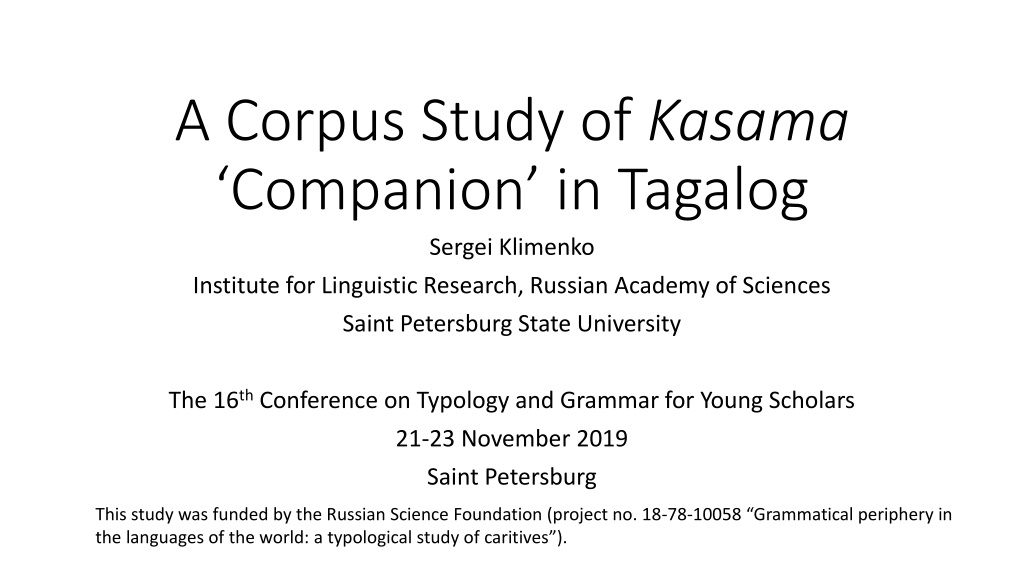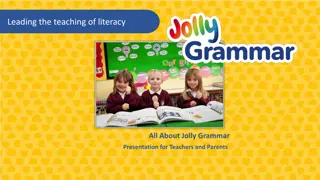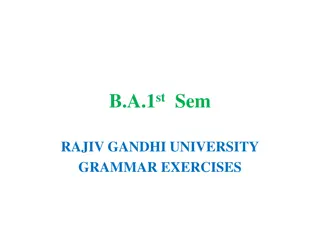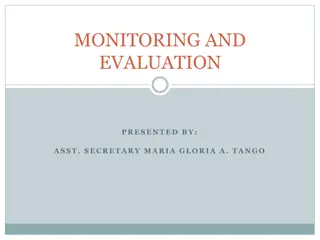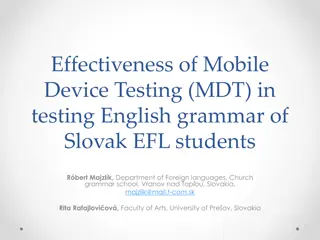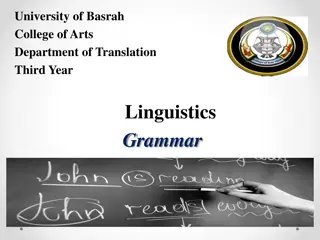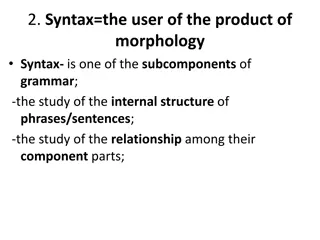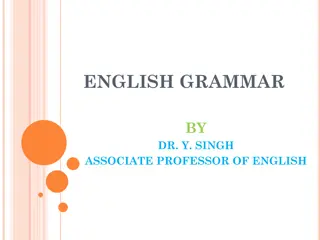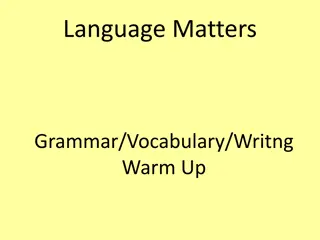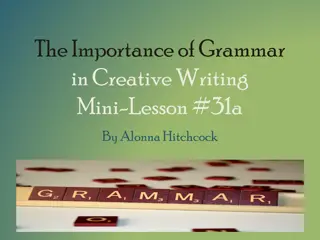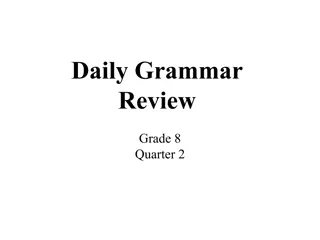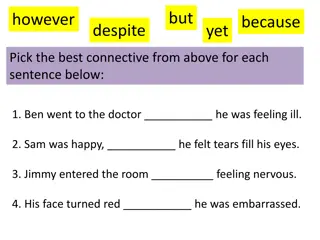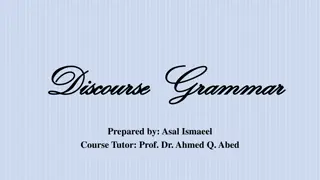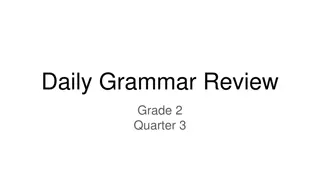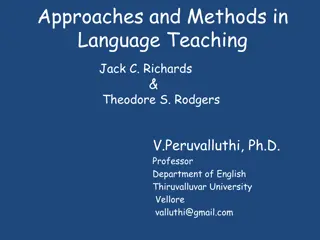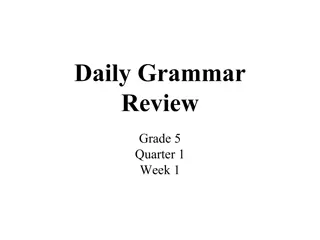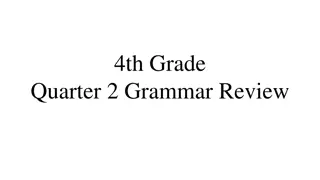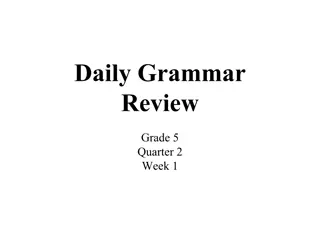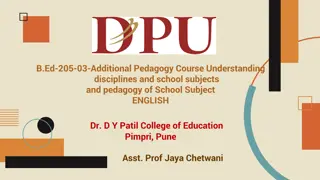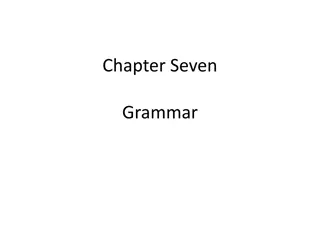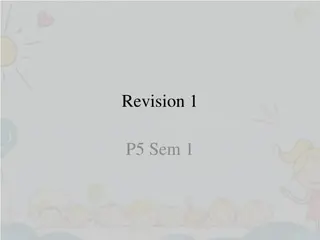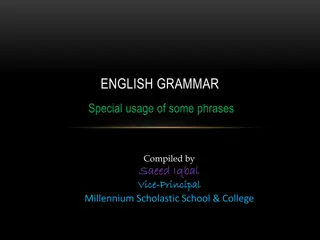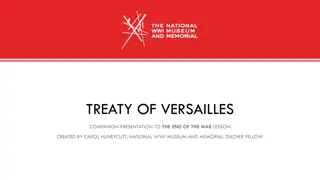Study on Kasama Companion in Tagalog Grammar
Study on the Kasama companion in Tagalog focuses on biclausal comitative constructions utilizing the morphosyntactic properties of kasama. The study explores the special properties of ka-nouns and the variations in kasama-clauses compared to adjunct clauses and adverbials/prepositions. Using data from the Tagalog corpus, the research delves into the grammatical peripheries and structure of Tagalog grammar.
Download Presentation

Please find below an Image/Link to download the presentation.
The content on the website is provided AS IS for your information and personal use only. It may not be sold, licensed, or shared on other websites without obtaining consent from the author. Download presentation by click this link. If you encounter any issues during the download, it is possible that the publisher has removed the file from their server.
E N D
Presentation Transcript
A Corpus Study of Kasama Companion in Tagalog Sergei Klimenko Institute for Linguistic Research, Russian Academy of Sciences Saint Petersburg State University The 16thConference on Typology and Grammar for Young Scholars 21-23 November 2019 Saint Petersburg This study was funded by the Russian Science Foundation (project no. 18-78-10058 Grammatical periphery in the languages of the world: a typological study of caritives ).
Outline Why kasama? Data Overview of Tagalog grammar Composition of the sample Special properties of ka-nouns Variation of properties in kasama-clauses Adjunct clauses vs. Adverbials & Prepositions Conclusion
1. Comitative verbs in Tagalog maki-/paki-verbs in Tagalog, described as comitative. Outside the scope of Arkhipov s definition of comitative: Morphosyntactic constructions with two individual participants (the core participant and the non-obligatory comitative participant) with the same semantic role expressed separately and with different structural ranks without repetition of the predicate denoting the situation (Arkhipov 2009:224).
2. Kasama companion Biclausal comitative constructions with kasama Fitting Arkhipov s definition much better. Briefly mentioned by Liao in typological study on maki-/paki-verbs in Philippine languages (2011:206). No data major descriptions of Tagalog (Schachter&Otanes 1972; Shkarban&Rachkov 2007; De Vos 2011; Malicsi 2013). Not included in another typological study on comitativity that has Tagalog in the sample (Stolz, Stroh & Urdze 2006).
3. Data Sketchengine.eu: Tagalog (Filipino) Web 2019 (tlTenTen19) online corpus (Jakub ek et al. 2013), 230 million tokens. 1,000 sentence random sample from 146,811 tokens of kasama.
4. Overview of Tagalog grammar: Case Marking Non-personal substantives & demonstratives: NOM, GEN, OBL. Personal nouns & personal pronouns: NOM, ACT, NACT.
5. Overview of Tagalog grammar: Inversion Constructions: Topicalization, Fronting, Non-emphatic Inversion (Rachkov 1966; Schachter&Otanes 1972:485-500; Frolova 1983; Shkarban 1989:93; Himmelmann 1991:10; Kroeger 1993b:123-124; Reid&Liao 2004:447; Nagaya 2007:353 ; Lee&Billings 2008:246): (1) Siya 3SG.NOM He is a real friend ay isa=ng one=LK tunay genuine na kaibigan friend TOP LK
6. Overview of Tagalog grammar: Linkers: na/=ng, nang (Schachter&Otanes 1972): Attributivizer Relativizer Complementizer Quantifiers Existential predicates + arguments Prohibitive marker huwag Fully reduplicated intensive adjectival forms Some conjunctions Adverbial phrases Adverbial clauses
7. Overview of Tagalog grammar: Linkers: na/=ng, nang (Schachter&Otanes 1972): Adverbials (point-time, frequency, manner, measure) Fully reduplicated intensive forms of verbs Some prepositions Adverbial clauses
8. Overview of Tagalog grammar: Linkers: distribution Based on (Schachter&Otanes 1972): na/=ng nang no linker topicalization paminsan-minsan sometimes yes yes yes yes lagi always yes no no no tatlo=ng oras three hours no yes no no pagkatapos ng/ang after no no yes yes dahil sa because of no yes yes yes
comrade'/'associate' 12 9. Composition of the sample bad' 4 metalinguistic use 2 magkasama 'two companions' 3 ka-sama [SHR-join] -- ka-usap [SHR-converse] interlocutor ka-edad [SHR-age] age mate ka-tabi [SHR-side] seat mate ka-talik [SHR-intimacy] sex partner bad data 93 independent use 430 substantive constructions 75 attributive constructions 85 (De Vos 2011:83) clausal constructions 296 total 1000
10. Independent use: (2) Kasama=nila=rito companion=3PL.ACT=PROX.OBL The prophet s cousin is with them here ang pinsan ng propeta prophet NOM cousin GEN
11. Dependent use: substantive, attributive, clausal (3) inip impatient kasama=ng companion=LK Ace said impatiently with a smile on her lips. na sabi ni said ngiti sa smile OBL Ace na may LK PRS.SG.ACT PN LK EXIST labi. lip
12. Dependent use: substantive, attributive, clausal (4) Nood watch[AV.IMP] and support[AV.IMP]=HON=2PL.NOMOBL bago=ng serye na kasama new=LK series LK companion NOM cousin=1SG.ACT na si Ms. Sunshine. at support=po=kayo sa ang pinsan=ko LK Watch and support the new series with my cousin Ms. Sunshine. PRS.SG.NOMPN
13. Dependent use: substantive, attributive, clausal predicative complement event oriented zero argument comitative depictive total verbs 184 16 12 - 215 3 verbals 24 2 2 - 28 0 non-verbals 33 7 1 12 53 0 total 296
14. Clausal: comitative, depictive, predicative complement, event oriented, zero argument (5) nag-punta si Joseph, Mary at Jesus kasama companion Jerusalem AV.PFV.STEM-go ng kanila=ng 3PL.ACT=LK Joseph, Mary and Jesus went to Jerusalem with their relatives PRS.SG.NOMPN mga kamag-anak relative PN sa and PN GEN PL OBL PLN
15. Clausal: comitative, depictive, predicative complement, event oriented, zero argument (6) Nag-mukmok=na=lamang=ako sa kwarto room AV.PFV.STEM-sulk=already=only=1SG.NOM kasama ng akin=g companion GEN 1SG.ACT=LK I just sulked in my room together with my books. OBL mga libro. PL book
16. Clausal: comitative, depictive, predicative complement, event oriented, zero argument (7) hindi=siya nam-u~muhay NEG=3SG.NOM nang kasama=sila companion=3PL.NOM he does not live with them. AV.IPFV.STEM-IPFV~live LK
17. Clausal: comitative, depictive, predicative complement, event oriented, zero argument nan-awagan sa mga deboto=ng mag-si-balik-an devotee=LKAV.STEM-PL-return-SOC sa mga barikada at mag-bantay, barricade and AV.STEM-guard wari ang panalangin=g apparently NOM prayer=LK ng kalangitan. heavens (they) called devotees to return to the barricades and to keep guard, apparently, together with the prayer that the heavens hopefully protect them. (8) AV.PFV.STEM-call OBL PL kasama companion kasi-han=sila protect-UV[INF] OBL PL sana ay OPT TOP GEN
18. Clausal: comitative, depictive, predicative complement, event oriented, zero argument (9) boring Ethan is boring to be with at the condo. si Ethankasama companion OBL sa condo. PRS.SG.NOMPN (17) Malakas strong Petra sings loudly. k<um>anta si <AV>sing[INF] Petra. PRS.SG.NOMPN (Schachter & Otanes 1972:249)
19. Special properties of ka-nouns: Adj + V complex predicates , reduplication (10) boring Ethan is boring to be with at the condo. si Ethankasama companion OBL sa condo. PRS.SG.NOMPN (Kroeger 1993b:141-144; Schachter&Otanes 1972:248-249): (11) Malakas k<um>anta strong <AV>sing[INF] Petra sings loudly. si Petra. PRS.SG.NOMPN (Schachter & Otanes 1972:249)
20. Special properties of ka-nouns: Adj + V complex predicates , reduplication (12) Tulog~tulog=lang ang g<in>awa=niya ITER~sleep=only He has just been sleeping for the whole day. (13) sakop ang buo=ng covered NOM whole=LK the whole table was covered with their books (14) Siya ang kala~ka-laro 3SG.NOM NOMITER~SHR-play Concha s playmate was him. whole day. NOM <PFV>do[UV]=3SG.ACT table ng mga libro~libro=nila GEN PL DISTR~book=3PL.ACT ni Concha. PRS.SG.ACT PN
21. Variation of properties: constituent order, argument marking, linkers (15) kasama=naman ng companion=EMPHGEN ng amin=g auntie sa States GEN 1PL.ACT=LK ng CD ng GEN GEN together with the Xbox that our auntie in the States sent to us, we got a basketball CD,.. Xbox na p<in>a-dala <PFV>CAUS-carry[UV] ay nag-karoon=kami sa amin 1PL.NACT LK OBL TOP AV.PFV.STEM-acquire=1PL.NOM basketball,..
22. Variation of properties: constituent order, argument marking, linkers GEN/ACT OBL/NACT NOM attributive (additive) 14 27 0 clausal (verb) 135 72 2 clausal (verbal) 23 6 0 clausal (non-verbal) 27 10 1 total 199 63% 115 36% 3 1%
23. Variation of properties: constituent order, argument marking, linkers na/=ng nang attributive 45 39 0 clausal (verb) 182 30 3 clausal (verbal) 26 3 0 clausal (non-verbal)35 6 0 total 288 78% 78 21% 3 1%
24. Variation of properties: constituent order, argument marking, linkers (16) sigaw shout ng GEN Tony shouted, leaving the room. (17) sabi=niya na said=3SG.ACTLK he said, closing his eyes ni Tony sabay simultaneous labas exit PRS.SG.ACT PN kwarto room sabay simultaneous pikit close_eyes
25. Variation of properties: constituent order, argument marking, linkers (18) Nag-kita=kami AV.PFV.RECP-see=1PL.NOM three=LK l<um>ipas. <AV>pass[PFV] We met three years ago. tatlo=ng taon=na year=already ang NOM
26. Variation of properties: constituent order, argument marking, linkers The only type of adverbial clauses in (Schachter&Otanes 1972:544-545): (19) <um>alis=siya nang/=ng <AV>leave[PFV]=3SG.NOMLK/LK ang prinsipal. NOM principal He left without having seen the principal. Not controlled adverbial clauses (Nagaya 2004:130): (20) T<um>akbo=siya nang naka-hubad=ako. <AV>run[PFV]=3SG.NOM LK He/She ran when I was naked. hindi=niya na-kita NEG=3SG.ACTPFV.MOD-see[UV] STAT-naked=1SG.NOM
27. Variation of properties: constituent order, argument marking, linkers aritive with kasama: (21) never=pa=niya=ng never=yet=3SG.ACT=LK iba=ng other=LK she has never slept in another house without her husband na-gawa na ma-tulog sa PFV.MOD-do[UV] hindi kasama companion spouse=3SG.ACT LK asawa=nya AV.INF.STEM-sleep OBL bahay na house LK NEG
28. Adjunct clauses vs. Adverbials & Prepositions na/=ng nang no linker topicalization paminsan-minsan sometimes yes yes yes yes lagi always tatlo=ng oras three hours yes no no no no yes no no pagkatapos ng/ang after dahil sa because of no no yes yes no yes yes yes
29. Conclusion: Biclausal comitative constructions with kasama mentioned but no descriptions. A variety of construction in the corpus: independent vs. dependent independent: additive vs. inclusory, predicative vs. substantive, animacy agreement. dependent: substantive, attributive, clausal. clausal: comitative, depictive, predicative complement, event oriented, zero argument. Variation of properties: constituent order: right periphery, topicalization, non-emphatic inversion, discontinuous. argument marking: nominative, genitive/actor, oblique/non-actor. linkers: na/=ng, nang, . Grammaticalized as a preposition? Ka-nouns are different from other nouns: Adj + V complex predicate construction reduplication iterative
30. Abbreviations: 1, first person; 2, second person; 3, third person; ACT, actor form; AV, actor voice; CAUS, causative; DISTR, distributive; EMPH, emphatic; EXIST, existential; GEN, genitive; HON, honorific; INF, infinitive; IMP, imperative; IPFV, imperfective; ITER, iterative; LK, linker; MOD, modal; NACT, non-actor form; NEG, negative; NOM, nominative; OBL, oblique; OPT, optative; PFV, perfective; PL, plural; PLN, place name; PN, personal name; PROSP, prospective; PROX, proximal; PRS, personal; RECP, reciprocal; SG, singular; SHR, shared notion; SOC, social; STAT, stative; STEM, stem-deriving prefix; TOP, topic marker; UV, undergoer voice.
31. References: Arkhipov, Alexandre. 2009. Comitative as a cross-linguistically valid category. New Challenges in Typology: Transcending the Borders and Refining the Distinctions, Trends in Linguistics. Studies and Monographs 217, ed. by Patience Epps and Alexandre Arkhipov, 223-246. Berlin & New York: Mouton de Gruyter. De Vos, Fiona. 2011. Essential Tagalog Grammar. Second Edition. A Reference for Learners of Tagalog. Frolova, Elena G. 1983. ang ay [On function words ang and ay in Tagalog]. Voprosy vostochnogo iazykoznaniia [Topics in the study of oriental languages], 240-246. Moscow: Nauka. Jakub ek, Milo , Adam Kilgarriff, Vojt chKov , Pavel Rychl , V t Suchomel. 2013. The TenTen corpus family. 7th International Corpus Linguistics Conference CL, 125-127. Lancaster. Himmelmann, Nikolaus P. 1991. The Philippine Challenge to Universal Grammar. Arbeitspapier Nr. 15 (Neue Folge). K ln: Institute f r Sprachwissenschaft, Universit t zu K ln. Kroeger, Paul. 1993b. Phrase Structure and Grammatical Relations in Tagalog. Stanford, CA: CSLI. Lee, Celeste, and Loren Billings. 2008. Clitic-pronoun clusters in Central Philippine. SEALS XIV, Volume 1, Papers from the 14th Annual meeting of the Southeast Asian Linguistics Society 2004, ed. by Wilaiwan Khanittanan and Paul Sidwell, 193- 203. Canberra: Pacific Linguistics. Liao, Hsiu-chuan. 2011. On the development of comitatitve verbs in Philippine languages. Language and Linguistics 12.1:205-237.
32. References: Malicsi, Jonathan C. 2013. Gramar ng Filipino. Quezon City: Sentro ng Wikang Filipino. Nagaya, Naonori. 2007. Information structure and constituent order in Tagalog. Language and Linguistics 81:343-372. Rachkov, Gennadij E. 1966. ay [Function word ay in Tagalog]. [Studies in Philology of Asian and African Countries], 89-94. Leningrad: Leningrad State University. Reid, Lawrence A., and Hsiu-chuan Liao. 2004. A brief syntactic typology of Philippine languages. Language and Linguistics 5.2:433-490. Schachter, Paul, and Fe T. Otanes. 1972. Tagalog Reference Grammar. Berkeley, Los Angeles, and London: University of California Press. Shkarban, Lina I. 1989. [Word order in Tagalog]. [Sketches on Word Order Typology], 75-108. Moscow: Nauka. Shkarban, Lina I., and Gennadij E. Rachkov. 2007. Reciprocal, sociative, and comitative constructions in Tagalog. Typology of Reciprocal Constructions, 887-932. Nedjalkov Vladimir P. Amsterdam: Benjamins Publ. Stolz, Thomas, Cornelia Stroh, and Aina Urdze. 2006. On Comitatives and Related Categories: A Typological Study with Special Focus on the Languages of Europe. Berlin: Mouton de Gruyter.
